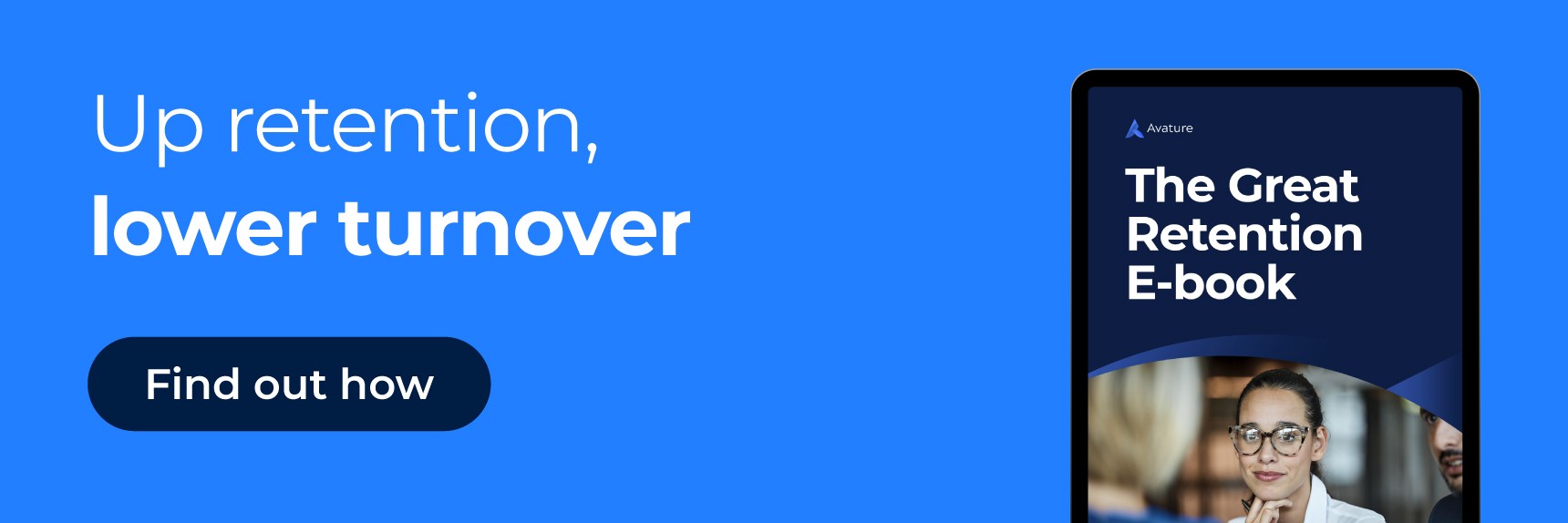Almost two years have passed since the onset of our current pandemic labor market. And yet, enterprise organizations continue to struggle to source and retain top talent. Today, we will review, in detail, a disruptive technology that can help organizations close skills gaps, future-proof their workforce and meet the ever-shifting expectations of the modern employee. That technology is the internal talent marketplace.
Table of Contents
The Great Resignation Sets the Stage
What is a Talent Marketplace?
What are the Benefits of Using a Talent Marketplace?
2. Improved Workforce Engagement
3. Streamlined Upskilling and Reskilling
4. Elimination of Organizational Silos
5. Meaningful Diversity, Equity and Inclusion Initiatives
Talent Marketplace vs. Internal Career Site
Elements of an Internal Talent Marketplace
1. Part of a Unified Talent Management Ecosystem
3. Comprehensive Employee Profiles
5. Robust Data Reporting and Analytics
Role of Change Management in Platform Adoption
Avature’s Take on Talent Mobility
Total Talent Management in Action
L’Oréal: A Case Study in Transparent Mobility
Deutsche Telekom: Delivering Meaningful Talent Engagement
Future-Proof Your Workforce With Avature
The Great Resignation Sets the Stage
If you have been paying attention to the talent landscape these past few years, you probably recognize that the rules of the game have changed.
Data shows that record numbers of employees are leaving their jobs, with more than 24 million US workers resigning between April and September 2021 (see this MIT study to learn more). With such unprecedented churn, organizations are looking for more advanced strategies to hold onto valued employees. While there are many factors influencing The Great Resignation – from compensation to pandemic response to job insecurity – most experts agree that it’s time for organizations to radically redefine their approach to talent mobility.
For a long time, employee development in the large enterprise was a rather simple formula:
- Hire an employee to do a specific job.
- Provide the employee with a direct manager in the same business area.
- Implement a formal structure for climbing the corporate ladder.
- The employee either climbs the ladder or gets off altogether.
In 2022? Not so much.
Worker preferences, particularly for Millennials and Gen Z, have shifted. Today, the modern employee expects a career pathway that incorporates traditional elements of the talent journey while also providing development opportunities personalized to the skills and preferences of each individual. In short, vertical mobility alone no longer cuts it.
The future of workforce retention will be defined by a holistic commitment to providing employees with a diverse, tailored and dynamic mobility journey. The internal talent marketplace is a crucial element to creating such an experience.
What is a Talent Marketplace?
A talent marketplace – also called an “internal talent marketplace” – is a two-way technology platform that utilizes advanced AI to better connect an organization’s employees with gigs, full-time roles, training, certifications and other internal growth opportunities.
Today, we have grown accustomed to the on-demand delivery of personalized products and services. From Uber to Amazon to AirBnB, we refuse to accept anything less than a tailored experience that meets our unique and individual preferences. And if a company falls short of our expectations? Well, we take our business elsewhere.
This same philosophy is now driving how organizations manage the employee development journey.
Rather than provide employees with cookie-cutter development paths, organizations are beginning to recognize the long-term value of delivering tailored mobility experiences that stimulate engagement, drive productivity, engender growth and return actionable insights to HR leaders and decision-makers.
While there exists a diverse range of agile solutions that can help companies drive this shift across each pillar of the talent management lifecycle (e.g., onboarding, performance management, engagement, etc.), when it comes to employee development, the internal talent marketplace reigns supreme.
What are the Benefits of Using a Talent Marketplace?
The defining value of the internal talent marketplace is that it helps position organizations to better understand their workforce and truly consider each employee’s potential. Remember, to a large degree, successfully combating employee attrition depends on how well an organization stimulates buy-in.
The internal talent marketplace encourages this crucial sentiment as it positions organizations to meet employee preferences in a way that aligns with company culture and long-term business goals. Beyond a satisfied and engaged workforce, talent marketplaces also provide several key business benefits, including:
1. Enhanced Business Agility
If the last two years of pandemic uncertainty have taught us anything, it’s that the need for business agility has never been greater. While this term can mean many things, Avature defines it as the ability of an organization to adapt to market changes, quickly develop comprehensive working solutions and maintain a tech-driven competitive advantage.
Note – this definition isn’t academic. Rather, it’s informed by our experience helping countless clients overcome some of the pandemic’s more complex challenges.
Talent marketplaces – and the technology that drives them – are essential to unlocking agility across the enterprise. By providing talent stakeholders with enhanced workforce visibility, organizations are better positioned to rapidly redeploy employees as priorities change. Rather than an obstacle or impediment to growth, talent marketplaces allow companies to leverage unexpected shifts in the market as opportunities.
2. Improved Workforce Engagement
As we have already highlighted, while we can attribute the recent wave of mass resignations to many factors, a driving force is employee disengagement.
When employees are effectively engaged, their values, vision and purpose align with their employer. However, as most Great Resignation studies show, an employee experience that fails to excite and provoke enthusiasm beyond an individual’s need to meet daily work responsibilities is a recipe for disaster.
Talent marketplaces empower employees and drive engagement by expanding the realm of development experiences beyond the traditional mobility paradigm of vertical progression. From temporary assignments (like project-based work) to personalized professional training opportunities, talent marketplaces engage employees in such a way that they can’t help but see a future where it matters most – your organization.
For a great example of how talent marketplaces drive quality engagement, check out L’Oreal’s talent mobility success story (note, we also review this story further below).
3. Streamlined Upskilling and Reskilling
Skills—the new currency of talent—can be summed up with a single question: How flexible is your workforce?
L&D initiatives are nothing new in the large enterprise. And yet, COVID-19 forced organizations to reassess the utility of short-term, ad hoc approaches to competency development. While many companies struggled to meet business needs in the face of hiring freezes and layoffs, others found that previous investments in agile upskilling and reskilling programs empowered their employees and enabled performance even in the thick of pandemic chaos (see our Delta Air Lines case study for one such example).
Talent marketplaces take upskilling (i.e., teaching employees new skills to optimize performance) and reskilling (i.e., training employees to adapt to a new role or gig) to the next level by focusing on experiential learning. Advanced AI algorithms and skills ontologies combine to match employees with personalized upskilling and reskilling opportunities that drive transparency and allow all employees to learn and develop in real time.
With Gartner HR Research recently reporting that 58 percent of the workforce will soon need additional skills to do their jobs successfully, talent marketplaces will play a crucial role in helping talent leaders future-proof their workforces.
4. Elimination of Organizational Silos
While many companies are slowly moving towards more agile work models, traditional hierarchies continue to exist.
And for all of the stability benefits that this model has traditionally provided organizations, it tends to impede the collaboration and communication needed to overcome the prominent business challenges of today. In this respect, knowledge is power, and organizational silos (both tangible and intangible) promote a business culture where knowledge sharing is limited.
Internal talent marketplaces are a powerful force for encouraging cross-functional collaboration and limiting or removing divisions between people and departments within the enterprise. Rather than isolating expertise within specific business segments, talent marketplaces democratize an organization’s knowledge economy. With a focus on resource accessibility and transparency, talent marketplaces stimulate the free flow of information while fostering innovation and boosting workforce productivity.
5. Meaningful Diversity, Equity and Inclusion Initiatives
Diversity, equity, and inclusion are not isolated programs or ideas – they are philosophical shifts in the acquisition and management of talent that will define the future of your organization.
Whether internal or external, candidates expect an equitable and unbiased experience when engaging with your company. With it comes to your internal talent (i.e., your employees), talent marketplaces help achieve DEI targets by empowering organizations to take a “skills-first” approach to candidate evaluations.
Thanks to transparent AI models that do not take personally identifiable or protected class information into account (e.g., age, gender identity, religion, race, ethnicity, etc.), internal talent marketplaces assist in the elimination of prejudicial hiring practices and help organizations make objective, data-driven assessments of internal candidates. The successful implementation of this strategy/solution will also further support the democratization of the knowledge economy, driving engagement from underrepresented segments of your workforce.
Talent Marketplace vs. Internal Career Site
Before diving into the elements that make up the talent marketplace, it is important to briefly highlight the difference between internal career sites (or job boards) and talent marketplaces.
This tends to be a point of confusion among our customers as, at first glance, it appears that the two share several common characteristics. After all, both are platforms utilized by HR stakeholders to post jobs and opportunities internally while opening and maintaining communication channels for career advancement.
Internal career sites can be considered a part of talent mobility 1.0.
That is to say, internal job boards were the first attempt to provide employees with more control over their professional development through a centralized and transparent internal hiring process. Rather than focus on employee empowerment, this first iteration of internal mobility tools aimed to reduce time-to-fill while saving both time and resources for the enterprise. To put it frankly, the needs and preferences of the workforce were almost entirely ignored.
Fast-forward to talent mobility 2.0 and the internal talent marketplace represents a radical shift in how HR stakeholders address employee engagement. Rather than a static and fixed mobility experience (i.e., one where all employees engage with the same content regardless of experience, skill set and career aspirations), employees are now served personalized mobility experiences that adapt to the needs and desires of each individual employee.
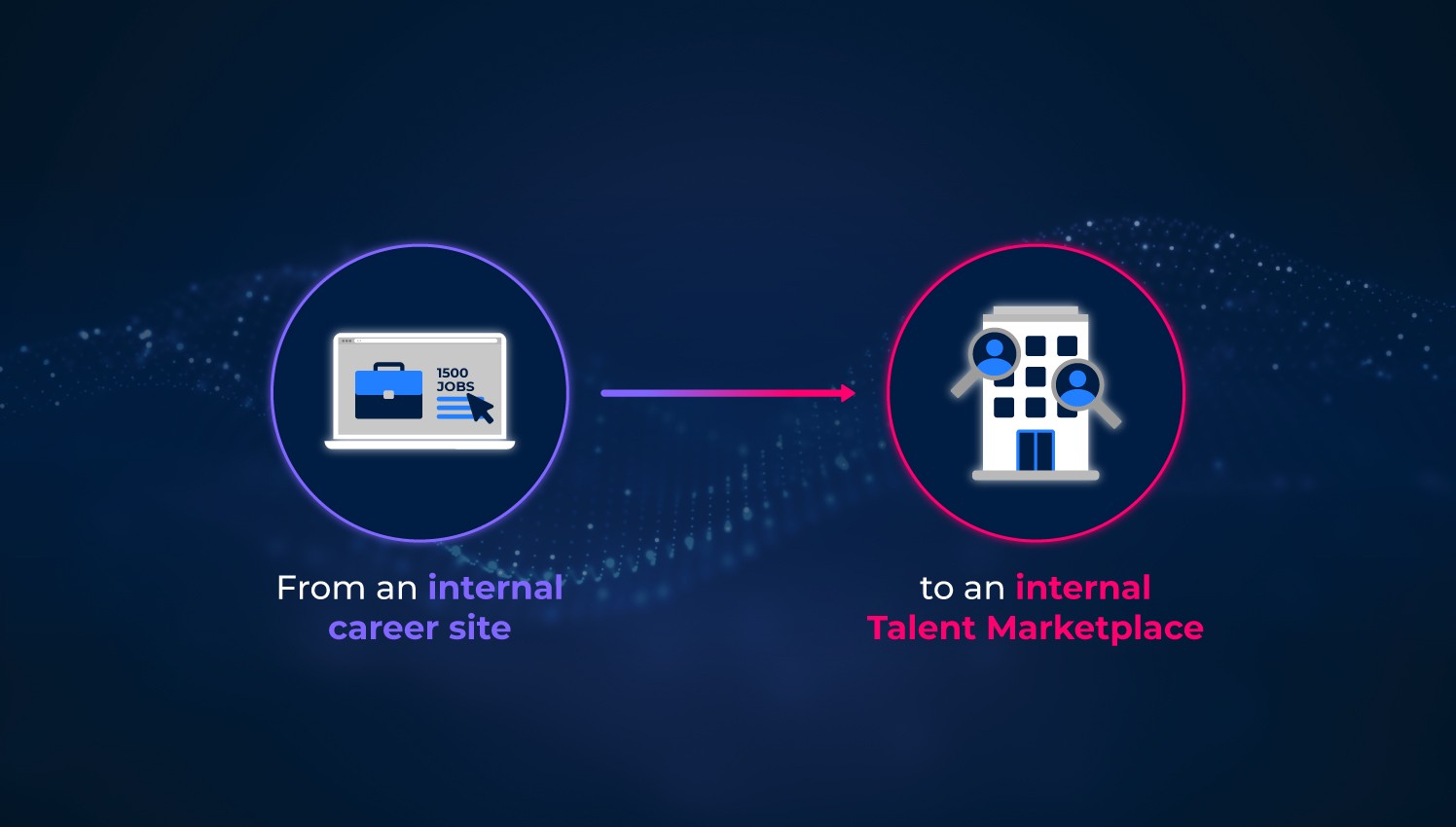
The driving force? Agile technology.
Today, advanced machine learning algorithms and AI not only match employees with relevant professional opportunities based on their skills and preferences, but they manage the search, hiring, onboarding and movement of people from role to role. In short, internal talent marketplaces provide both employers and employees with a dynamic, personalized and holistic end-to-end talent management platform. These platforms drive engagement, improve retention and shift organizational culture with an employee experience unlike anything seen in talent mobility 1.0.
Elements of an Internal Talent Marketplace
While platform features and capabilities are likely to vary from vendor to vendor, there are some elements that all talent marketplaces have in common. Here are five characteristics of the internal talent marketplace that have proven to be essential (and, in our opinion, indispensable) in the shift to talent mobility 2.0.
1. Part of a Unified Talent Management Ecosystem
Talent stakeholders are only as effective as their tools.
With more and more organizations looking to replace limited-purpose, rigid and outdated point solutions, an aligned, integrated and consistent talent experience has never been more critical. As a crucial stop on an end-to-end talent journey, the internal talent marketplace must seamlessly integrate across the employee lifecycle. In essence, the solution should assist your organization in its quest to move on from disparate technology systems and build a unified talent management ecosystem.
While isolated point solutions (i.e., tools that serve a single HR purpose) were an effective answer to legacy systems, they are by no means perfect. In fact, their dependency on integrations to deliver a more complete talent experience has long been their Achilles heel. A modern internal talent marketplace, in contrast, helps fully connect all of an organization’s talent activities while facilitating the exchange of data across multiple solutions within a single platform—from HRMS to LMS to the employee engagement hub.
Remember, without access to a unified data framework, your talent solutions might as well be digital paperweights. As a part of a single system, the internal talent marketplace drives the employee management and talent optimization data repositories needed to import data from each touchpoint of the employee lifecycle.
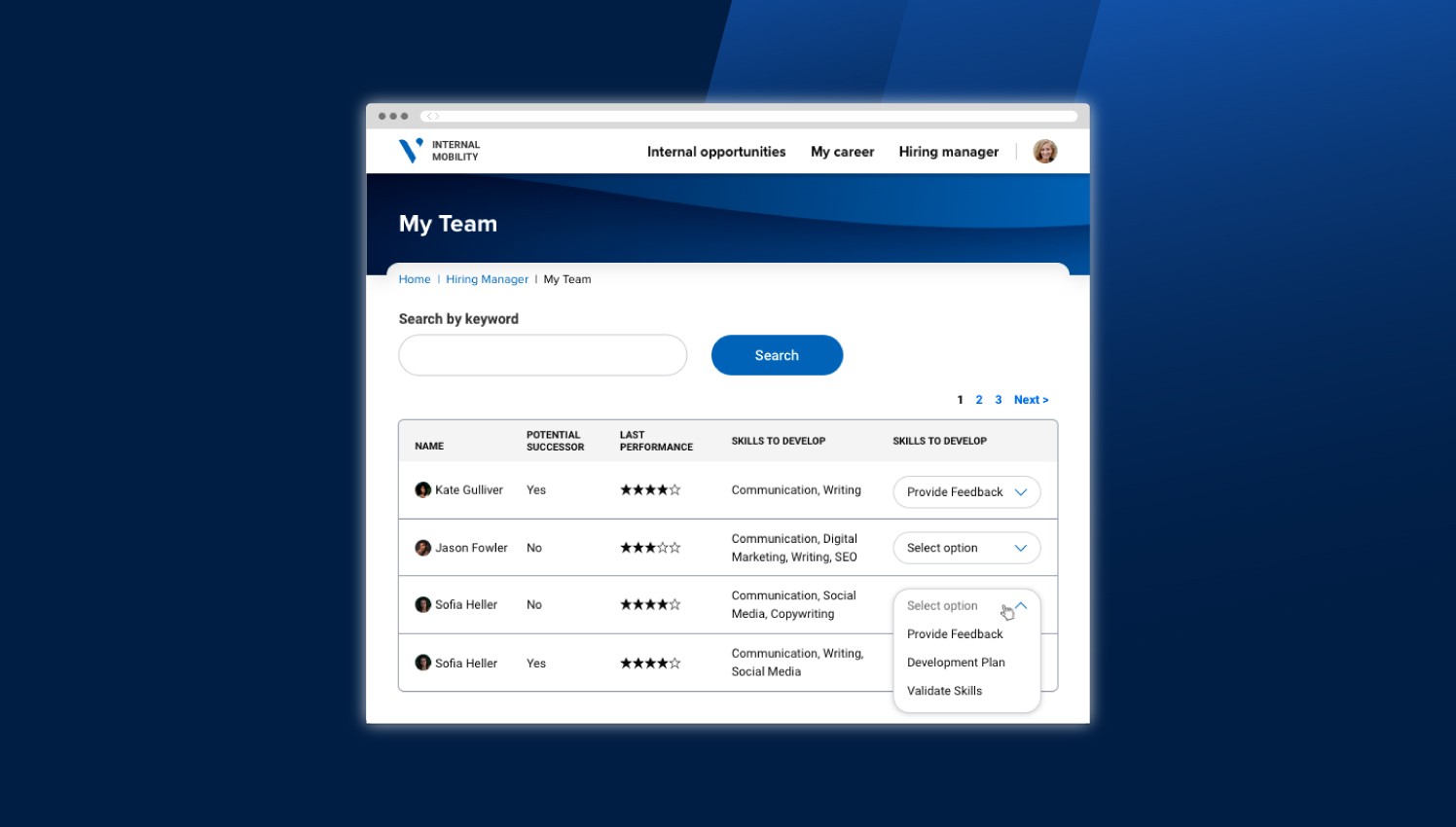
The result? A consistent, accurate and informed solution ecosystem to better manage internal applications, offboard and onboard employees, gather project feedback and automatically trigger tailored employee development processes.
2. True Platform Flexibility
Talent management isn’t an exact science, and no two organizations manage talent in exactly the same way. While the talent mobility framework for one organization may be intimately tied to learning and development, HR leaders at another may prefer a more traditional performance-based approach. True platform flexibility means that talent stakeholders have the freedom to personalize their talent marketplace solution to the needs and preferences of both the company (i.e., culture, history, values, etc.) and employees.
In addition, as talent management best practices continue to evolve, companies will inevitably need to make future adjustments to the employee experience. Think about where we are now compared to two short years ago, and how much has changed in the aftermath of COVID-19. Many organizations have had to accelerate their digital transformations as a number of key touchpoints across the talent management lifecycle have become either semi or fully digital. Those organizations with agile talent solutions were (and will continue to be) better positioned to adjust to change.
Now, one important caveat: most HR technology providers still need to improve their solution flexibility.
While “off-the-shelf” configurations are great for rapid solution deployment, the future of the talent marketplace (and of all talent solutions for that matter) will go beyond one-size-fits-all templates. As HR guru Josh Bersin noted in early 2021, the talent experience will soon be defined by “truly adaptable HR software.”
3. Comprehensive Employee Profiles
One of the main aims of the internal talent marketplace is to drive workforce agility by providing employees with transparent, relevant and curated growth opportunities. Comprehensive employee profiles help anchor this agility as they effectively tell the story of each and every member of an organization (i.e., from their skills to career aspirations to personal interests). Rather than exist in isolation, the talent marketplace and employee profile combine to consolidate and leverage this data across the talent lifecycle. Organizations can utilize the resulting “people analytics” to provide employees with a holistic and on-point mobility experience.
4. Advanced AI Capabilities
As the defining feature of the internal talent marketplace, advanced AI helps organizations address three key concerns:
- Data volume.
- Insight scalability.
- Skills management.
Again, at the risk of being redundant, it is important to highlight the importance of skills as the new currency of talent. As a relatively new concept, “skills” pose several challenges to talent stakeholders – from terminology to tracking to criteria/library updates. The internal talent marketplace addresses these concerns and challenges. It provides an AI-driven skills network (one capable of managing large volumes of data) that connects the data dots in a way that far surpasses even the most skilled HR analyst. It also helps organizations identify and understand skills – in all their nuance – at scale.
Specifically, expansive skills ontologies position talent leaders to provide more relevant opportunity recommendations to employees while also highlighting both individual and organizational skills gaps. A best-in-class internal talent marketplace should be powerful enough to take a set of required skills, compare it with an internal candidate’s current competencies and provide accurate opportunity recommendations in the form of training and tailored development experiences.
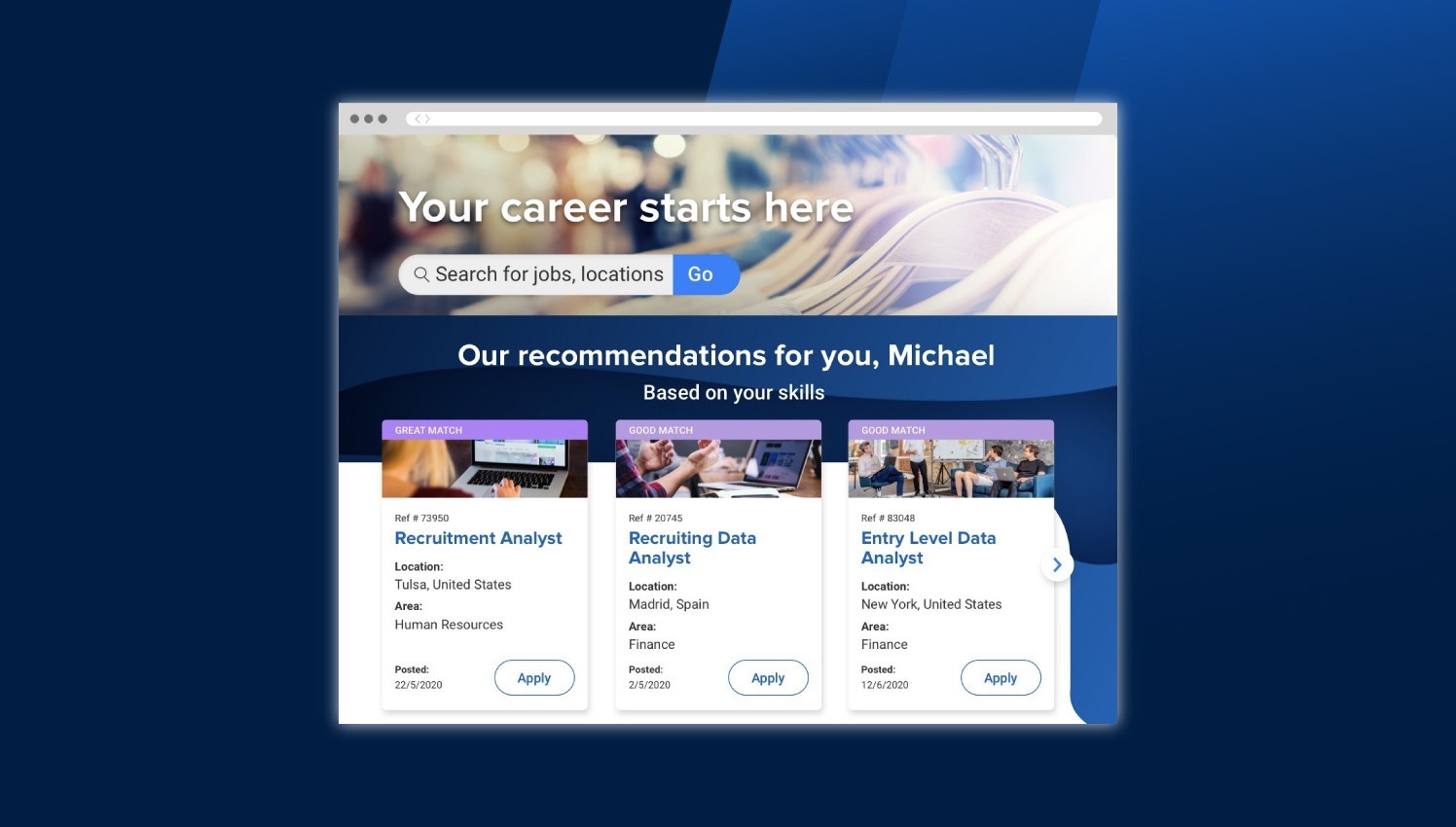
Not only does this type of AI technology position HR leaders to more effectively plan and implement company-wide talent management initiatives, but it also provides employees with the transparency they crave with respect to opportunity “readiness” (i.e., the skills they already have versus the minimum skills required for opportunities they are interested in). In this way, talent leaders can stop worrying about the data grunt work, and employees can better understand the next crucial steps in their career development as they design a professional pathway suited to their interests and needs.
Other AI features common to talent marketplaces include candidate rankings and semantic models that go far beyond mere keyword matching. If you want to learn more about our approach to Artificial Intelligence, check out our recent interview with Avature’s resident expert on everything AI, Rabih Zbib.
5. Robust Data Reporting and Analytics
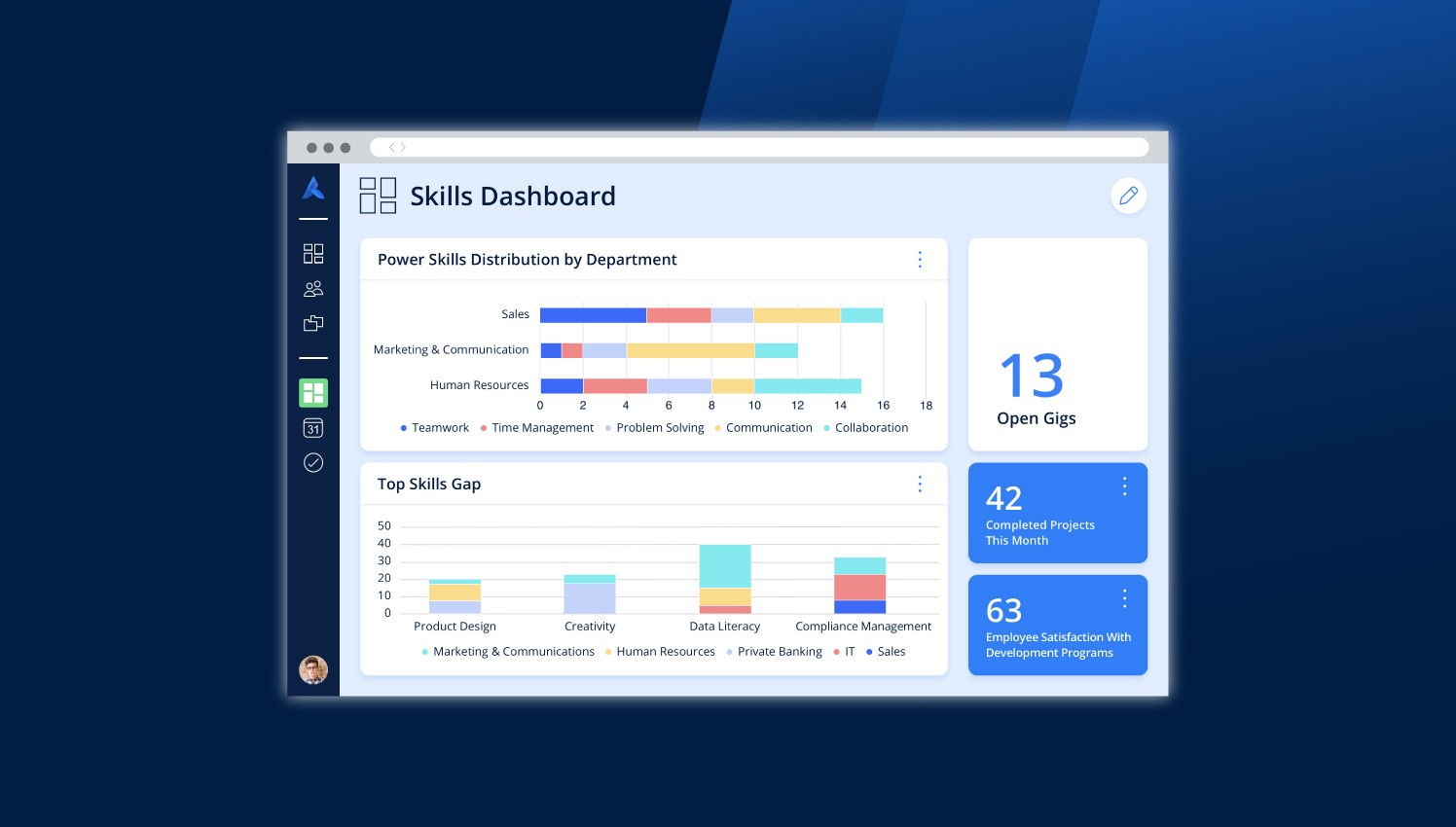
Finally, an internal talent marketplace will position organizations to make informed talent decisions with comprehensive data reporting and analytics. The key here is that talent leaders have the freedom to consolidate, measure and analyze the data that they deem most valuable. There’s no reason to assume that the data that matters to one organization will prove mission-critical to another. Note that data reporting functionally is likely to vary from vendor to vendor. Most tend to offer static data models with a fixed set of measurable metrics. In an ideal world, all vendors would follow Avature’s lead and provide their customers with a customizable data model – one which leaders can tweak over time to collect, process and collate large amounts of information to generate actionable, relevant and pertinent insights at scale.
Role of Change Management in Platform Adoption
Even under the best of circumstances, implementation and adoption of new solutions are difficult.
Effective change management initiatives hinge on workforce buy-in, and the internal talent marketplace is no different. Not only do change management best practices apply here, but a successful adoption will also require a significant shift in company culture. That is to say, companies will need to focus on redefining workforce engagement, career development and the mobility journey across the enterprise.
At Avature, experience has taught us that of all the change management challenges organizations are likely to face – from securing financial resources to designing an inclusive solution – workforce resistance tops the list. While there are many effective strategies for overcoming employee resistance (check out our article, SaaS Adoption and Effective Change Management to learn more), we recommend that organizations focus their attention on management buy-in.
Why managers? Because they are THE KEY to stimulating the necessary shift in a company’s mobility culture.
Not only are they the gatekeepers of the employee experience, but they are also likely to be accustomed to traditional models of career development. Organizations must effectively communicate with managers to help them understand the retention and workforce agility benefits of implementing an internal talent marketplace. It is only once they are fully bought in that HR leaders can ensure a smooth and positive solution transition – one that successfully eases employees into a new era of talent mobility.
Note that the many benefits of managerial buy-in are further highlighted in our Deutsche Telekom customer story below. Continue reading to learn more!
Avature’s Take on Talent Mobility
Avature’s talent mobility framework is driven by a desire to build a comprehensive, end-to-end talent journey—one that stimulates, develops and positions employees to reach their full potential across the talent lifecycle.
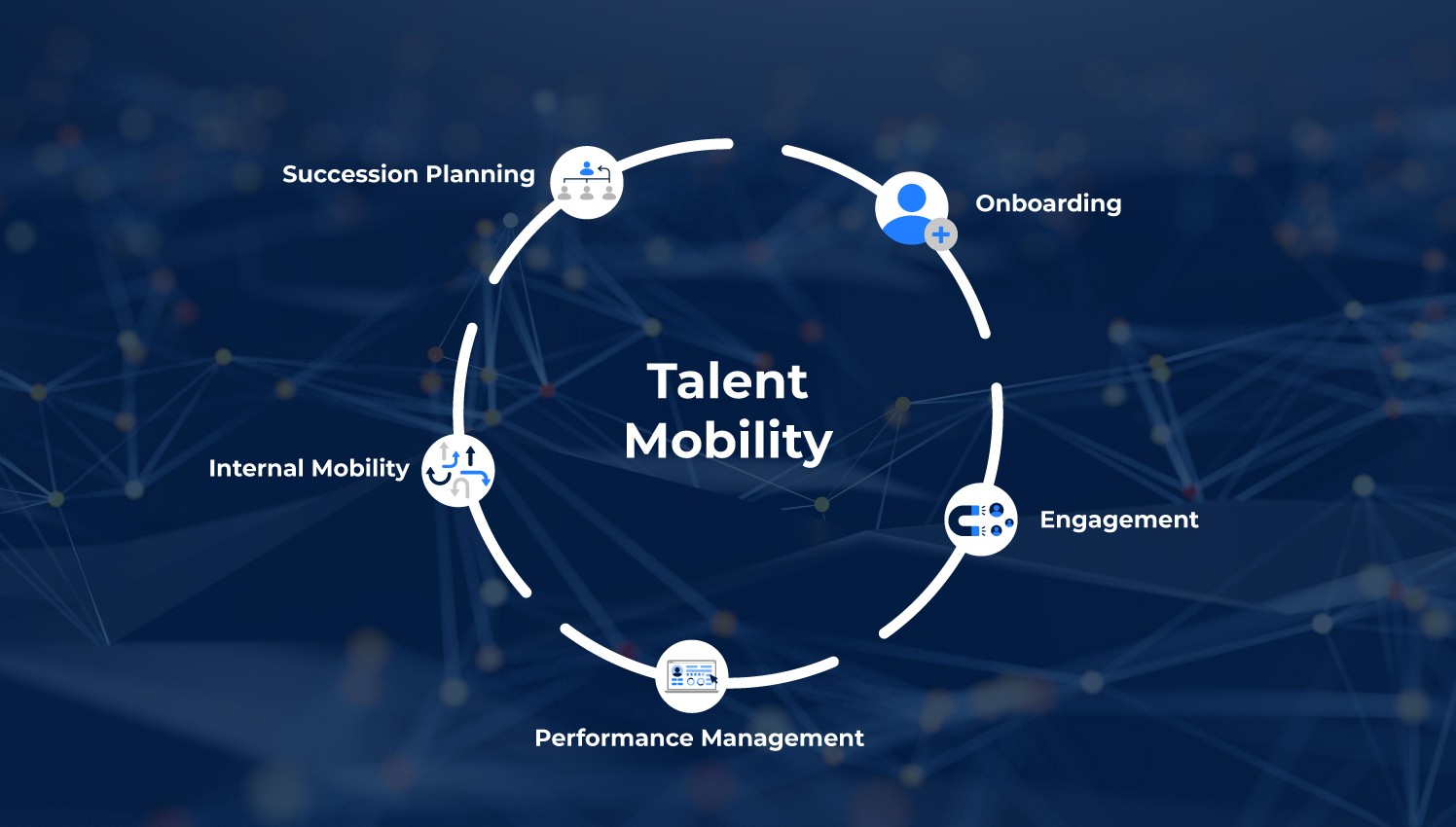
While the internal talent marketplace represents a pivotal stop on this journey, we also recognize that effective mobility doesn’t happen in isolation. For organizations to truly align the talent experience with long-term business priorities, they must merge the core pillars of enterprise talent management, bridging the gaps between onboarding, performance management, employee upskilling, career pathing and workforce engagement.
For this reason, we offer our customers a one-platform approach to talent management that provides a dynamic employee experience and is guided by talent intelligence. With a focus on agile technology (including platform-native AI), intelligent reporting and workforce analytics and sustainable engagement, our multi-solution ecosystem delivers the full spectrum of talent management tools that enterprise organizations need to optimize their strategic talent initiatives.
This unified approach to talent management is powered by five unique but interconnected solutions:
- Avature Onboard
- Avature Internal Mobility
- Avature Performance Management
- Avature Succession Planning
Leaning on our 15 years of experience and expertise as pioneers in CRM for recruiting, we understand that talent is all about building and maintaining relationships. Avature’s unique approach to talent management allows organizations to go beyond individual talent touchpoints. With a multi-solution, single-platform approach, talent leaders can integrate and manage the entire employee lifecycle (from hiring to onboarding to development) and do so in a way that makes sense for their company.
Total Talent Management in Action
Avature’s talent management ecosystem is, at its core, a relationship-building platform driven by its users. With 65 percent of our platform features developed in collaboration with our customers, they play a vital role in helping us define the future of all things talent. With this fact in mind, it’s time to learn more about how our customers are taking advantage of our one-platform approach to tackle some of today’s most complex mobility challenges.
L’Oréal: A Case Study in Transparent Mobility
One of the keys to a successful talent mobility framework is transparency.
Ideally, “talent transparency” will manifest at three different levels throughout the employee mobility experience:
- Employees should have clarity with respect to available growth opportunities.
- Talent leaders (i.e., both management and HR) need to intimately understand which skills and gaps exist across their organization.
- There needs to be transparency in how organizations develop internal career pathways.
When L’Oréal, one of the world’s largest cosmetics companies, discovered that a lack of opportunity transparency created a negative employee experience, they turned to Avature for help. Specifically, internal surveys revealed that 50 percent of current L’Oréal employees desired more visibility in their mobility experience. In addition, exit interviews found that 56 percent of outgoing employees highlighted a lack of career path transparency as a significant factor in their decision to move on from the company.
With this vital information in hand, L’Oréal sought to radically redesign its approach to talent mobility by providing employees with a more engaging and transparent experience through an internal talent marketplace known as the “Positions Open Portal” (or “POP”). Built with Avature’s best-in-class mobility technology, L’Oréal’s goal was to create a global talent marketplace capable of providing employees with more control over their development and growth.
“Employees are architects of their own career.”
Niilesh Bhoite
Chief Digital Officer at L’Oréal
Deployed in 2018 across 70 countries, the solution not only reduced the role of HR in certain talent activities such as internal applications and employee referrals, but it dramatically improved the transparency of L’Oréal’s mobility program. Concerning the latter, POP helped L’Oréal meet all three levels of talent transparency by providing employees with tailored notifications for position openings, training and other growth opportunities relevant to each employee’s experience, goals and skill set.
As a result of POP, L’Oréal has seen a 40 percent increase in roles filled by internal candidates. This has led to significant improvements in the mobility experience (as employees now feel empowered to define their professional future) and a decrease in both hiring costs and employee churn.
To learn more about L’Oréal’s success story, check out our video interview with Niilesh Bhoite, the company’s Chief Digital Officer.
Deutsche Telekom: Delivering Meaningful Talent Engagement
With over 215,000 employees worldwide, Deutsche Telekom is one of the world’s leading digital telco companies.
The company has long favored providing its employees with a holistic, engaging and agile talent experience. Yet, having recently recognized the dramatic correlation between the quality of an organization’s talent and positive business performance in the ongoing pandemic environment, Deutsche Telekom’s talent leaders enlisted the help of Avature to bring the company’s mobility vision to life.
“You don’t want your talent to be sifting through a list of jobs or development opportunities, you want to give them what they need at the right place and at the right time. And Avature really enabled us to do this with its white-box approach towards algorithms.”
Pranav Chadha
Senior Technical Product Manager at Deutsche Telekom
This collaboration aimed to achieve several goals for the employee development journey.
First, the project’s initial scope focused on building a talent marketplace that could prioritize “readiness” and deliver the top one percent of employees a personalized mobility experience through tailored job, gig and project recommendations. As an organization with a rich heritage of employees who have worked at the company for many years, Deutsche Telekom wanted to find a way to create an engaging environment that provided its employees with attractive reasons to remain with the company.
Second, in addition to showcasing interesting growth opportunities such as training and open positions, Deutsche Telekom also wanted to encourage collaboration and discourse among business leaders and top-tier employees. Therefore, in parallel to their talent marketplace, they also created a talent communication hub to stimulate meaningful engagement. Within their initial test group of employees, they included executives assigned to act as sponsors for another talent hub member’s upcoming succession step. Through two-way communication, the company aimed to position top talent to receive advice and guidance from their peers on the best ways to grow within the organization.
With Avature’s help, Deutsche Telekom successfully achieved both of its goals. The next phase is to replicate, expand and offer this high-touch, personalized and engaging employee experience to additional segments of the telco’s global workforce.
Future-Proof Your Workforce With Avature
Talent management is evolving, and the need for a truly dynamic employee experience has never been greater. With the ability to provide enterprise organizations with a people-centric, data-driven and “skills-first” approach to employee mobility, internal talent marketplaces are set to redefine the new war for talent. If you want to learn more about leveraging Avature’s internal talent marketplace solution to future-proof your workforce, contact our experts and schedule a demo today.

